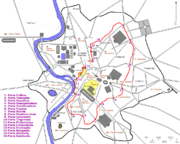
Carmenta
Encyclopedia
- For the genusGenusIn biology, a genus is a low-level taxonomic rank used in the biological classification of living and fossil organisms, which is an example of definition by genus and differentia...
of LepidopteraLepidopteraLepidoptera is a large order of insects that includes moths and butterflies . It is one of the most widespread and widely recognizable insect orders in the world, encompassing moths and the three superfamilies of butterflies, skipper butterflies, and moth-butterflies...
, see Carmenta (moth)Carmenta (moth)Carmenta is a genus of moths in the Sesiidae family.-Species:*Carmenta albociliata *Carmenta anthracipennis *Carmenta apache Engelhardt, 1946*Carmenta arizonae...
In ancient Roman religion
Religion in ancient Rome
Religion in ancient Rome encompassed the religious beliefs and cult practices regarded by the Romans as indigenous and central to their identity as a people, as well as the various and many cults imported from other peoples brought under Roman rule. Romans thus offered cult to innumerable deities...
and myth
Roman mythology
Roman mythology is the body of traditional stories pertaining to ancient Rome's legendary origins and religious system, as represented in the literature and visual arts of the Romans...
, Carmenta was a goddess of childbirth and prophecy, associated with technological innovation as well as the protection of mothers and children, and a patron of midwives. She was also said to have invented the Latin alphabet
Latin alphabet
The Latin alphabet, also called the Roman alphabet, is the most recognized alphabet used in the world today. It evolved from a western variety of the Greek alphabet called the Cumaean alphabet, which was adopted and modified by the Etruscans who ruled early Rome...
.
Background

Evander
In Roman mythology, Evander , also spelled Euander, was a deific culture hero from Arcadia, Greece, who brought the Greek pantheon, laws and alphabet to Italy, where he founded the city of Pallantium on the future site of Rome, sixty years...
and along with other followers they founded the town of Pallantium
Pallantium
Pallantium was an ancient city near the Tiber river on the Italian peninsula. Roman mythology, as recounted in Virgil's Aeneid for example, states that the city was founded by Evander of Pallene and other ancient Greeks sometime previous to the Trojan War...
, which later was one of the sites of the start of Rome. Gaius Julius Hyginus
Gaius Julius Hyginus
Gaius Julius Hyginus was a Latin author, a pupil of the famous Cornelius Alexander Polyhistor, and a freedman of Caesar Augustus. He was by Augustus elected superintendent of the Palatine library according to Suetonius' De Grammaticis, 20...
(Fab. 277) mentions the legend that it was she who altered fifteen letters of the Greek alphabet to become the Latin alphabet, which her son Evander introduced into Latium.
Carmenta was one of the Camenae
Camenae
In Roman mythology, the Camenae were originally goddesses of childbirth, wells and fountains, and also prophetic deities.There were four Camenae:*Carmenta*Egeria*Antevorta, or Porrima...
, and the Cimmerian Sibyl
Cimmerian Sibyl
thumb|right| Cimmerian Sibyl by [[Guercino]].The Cimmerian Sibyl, by name Carmentis, was the prophetic priestess presiding over the Apollonian Oracle at Cimmerium in Italy, near Lake Avernus . This sibyl may have been a doublet for the Cumaean since the designation Cimmerian refers to priestesses...
. The leader of her cult was called the flamen carmentalis.
It was forbidden to wear leather
Leather
Leather is a durable and flexible material created via the tanning of putrescible animal rawhide and skin, primarily cattlehide. It can be produced through different manufacturing processes, ranging from cottage industry to heavy industry.-Forms:...
or other forms of dead skin in her temple, which was next to the Porta Carmentalis in Rome.
Her festival, called the Carmentalia
Carmentalia
Carmentalia was the feast day of the Roman goddess Carmenta, an ancient oracle who later was deified by the Romans. She had her temple atop Capitoline Hill. Carmenta was invoked in it as Postvorta and Antevorta, epithets which had reference to her power of looking back into the past and forward...
, was celebrated primarily by women on January 11 and January 15.
Primary sources
- Ovid, Fasti i.461-542
- Servius, In Aeneida viii.51
- Solinus, Collectanea rerum memorabilium i.10, 13
Secondary sources
- The Dictionary of Classical Mythology by Pierre Grimal, page 89 "Carmenta"
- The Book of the City of Ladies, by Christine de Pizan, section I.33.2

